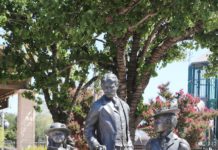No one could have expected that rushing to get the new sod on at
Live Oak
’s Richert Field would have caused such a hassle when the
planning began two years ago.
No one could have expected that rushing to get the new sod on at Live Oak’s Richert Field would have caused such a hassle when the planning began two years ago.
The Morgan Hill Pop Warner team was the first to go, costing the nonprofit organization about $5,000 per day in loss of revenue from the gate and snack shack revenue. And now even the Live Oak football team was kicked off its own field.
The field won’t be available for tonight’s game, but district officials plan to use it for Homecoming the following week.
“From all indications we have from talking to people is that it is safe,” Deputy Superintendent Bonnie Branco said Thursday. “We are bringing in the risk manager and all the players tomorrow to confirm that. We took the allegations that it wasn’t seriously. We want to make sure the kids will be safe if that is possible playing football.”
“We have someone coming out from the district insurance coming out tomorrow to access and determine whether we can use it for the three remaining home games,” added Live Oak Principal Nancy Serigstad.
But even if the field is deemed safe to play on, it will be on a limited basis, Branco said. Most activities on the field like Pop Warner will be banned for the time being, and even the district would be limited by what activities were performed on it.
“We need to give the ground rest so it can take root like was originally intend,” Branco said. “It can take a little activity but not much. We will determine Friday what uses can be allowed. The real issue is just having too many activities on it period. It is not just one team but a culmination of continued use. The primary function would be for the district first. We still have to take a look at its uses then.”
Part of the problem came from not having the final approval from the designer to use it.
“We were actually surprised that they were using it,” said Jay Beals, the owner of Beals Sports who first found out that it was in use after an employee brought a recent Times column to his attention about a week ago.
“The contractor said as long they took it over as far as maintenance goes, they wouldn’t have any problems with it. But as the designers, we didn’t determine whether it was in a turnover state. Typically we would have a final walkthrough.”
In Beals’ preliminary review on Aug. 11, the field wasn’t ready, and there were several things listed for Jensen Corp, the contractor, to fix. But because football season was nearing, Beals didn’t have the chance to review it.
Jensen did not return phone calls for this story.
“The challenge is we never got to go back through and see if they corrected everything and finished our soil samples,” Beals said. “Whenever there is a turnover, we always have the contractor go through all the procedures he needed and have all the manuals turned over to the owner. We will do a final test for disease in the grass and check to see if the rooting is deep enough.”
Beals also does wear and tear tests on the field, finding out all the uses for the field and verifying that the field will hold them.
“We would prefer one full season of growing before play,” Beals said. “When we design college and professional fields that is what we do to make sure. Obviously, we didn’t have that. We never know if it is going to be ready until we test the roots.”
The field had about two months to grow into place. When sod is laid, the roots are cut so it can be rolled up. The roots should normally attach in the first 30 days after the fertilizer is placed, Beals said. After that the field should be mowed two to three times a week to help it grow.
“Every time you cut off the top, the roots grow deeper,” Beals said. “On some of the fields we do, we have them mow it twice a day because they can afford to pay for it. You could get six inches of root growth in 30 days or you could get zero. It is not like building a house or wall. When you finish building it you are done, but that is not the case in a living field.”
The field was started late because of the December rains that make the field too muddy for heavy equipment to be on.
If the field were seeded rather than sodded, Beals would not have allowed it to be used for soccer or football for six months. With the exclusion of December through April, the time could be closer to a year.
“The good thing about sod is that it takes root faster than seed,” Beals said. “It doesn’t go as deep as seed though but still is able root quite well.”
The track was built first before the football because of the finances available at that time. But ideally it would have been the other way around to give the field more time to get settled in, Beals said.
“We were trying to put the package together for the dollars they had,” Beals said. “If you want to buy a Cadillac but you only have money to buy a Chevy, you are not going to end up with a Cadillac. If your great uncle dies, you may be able to trade it in and buy a Cadillac.”
Once the track was finished, Beals hired a separate contractor to come in and do the field.
Originally, Beals recommended a hybrid Bermuda sports turf. The hybrid Bermuda, unlike the lawn grass which grows rampant, is about half an inch to an inch tall and grows in warmer climates.
“They grow the same way,” said Beals about the lawn and turf versions. “They are very voracious. They have a good solid matting of stolon (the base of the grass that produces new plants). Those stolons are important for football because they keep the dirt covered and keep everything together.”
But putting in this type of grass required the additional purchase of a real type mower that would only be used on that field. Rather than spending the additional $15,000 to $20,000 needed for the extra investment, the district chose to go with the much less durable but still feasible option of Blue Rye grass.
“One thing that apparently wasn’t clear when we switched over is that you can’t put as many programs on it and you can’t put them on as soon,” Beals said. “We believe the field was built right and the sod was put on correctly.”
The grass that was put in was not the No. 1 choice for the field, but it is the top choice for fields in coastal regions with damper climates. It was actually the same field used at the San Francisco Giants Pacific Bell Park, according to Delta Blue Grass, the grower. But the grower actually grows it in a medium similar to that of the park.
“The mix itself is the same seed mix as in Pac Bell,” Beals said after confirming with Delta. “They can’t tell me if it is proportionally identical for proprietary reasons. The percentages may not be the same, but it is the same 50/50 high use and low mow mix. It uses seven different types of grass.”
The first choice when plans were originally discussed two years ago was to install both a synthetic track and turf.
“They were $412,000 short,” Beals said. “That is why they made the decision to go with turf because they didn’t have anyone to hand them a check for the amount like someone did recently with one of our projects in Sacramento.”
Beals said Thursday that artifical turf would have cost the district approximately twice what the sod did.
When the field was installed, it was initially swamped so the turf would take root. But after it was installed, it wasn’t watered for five days in the heat and dried out as a result. It was then watered real heavily again, drowning the roots. Watering and then not watering can causes diseases in the grass, Beals said.
A couple of those diseases are Pythium and Black Layer.
“There is evidence that both of those are present in the field because it was stressed with the varying watering,” Beals said.
After Beals heard about the problem, he sent a contractor out to knife arrogate the field to get air into the pockets that dried out and to deep tynyriate the field. The company also did a soil analysis and determined that the soil was healthy.
The clods and clumps on the field, according to Beals, result because there is too much buildup between the turf and dirt. The knife aeration helps break up the phatch and helps air and water to get down to allow a deeper root system.
“There are 4 million plants in a football field,” Beals said. “Each piece of grass with its own root system is a plant like a tree or shrub. They need the same things people need: water, food, air and rest. Babies and young people can’t take as must stress as older people. Turf is the same way.”
To tynyriate the field costs about a nickel per square foot, and the aeration costs about two and a half cents, Beals said. There are about 80,000 square feet on the field.
“At this point in time we have said that the contractor needs to do the work,” Beals said. “He was asked to do it by the school district. Right now I don’t really care about the costs, I just want the darn thing fixed.”
Live Oak has just one groundskeeper who is responsible for everything at the school.
“If we would have turned over the field, we would have schooled the groundskeeper on what needs to be done, how much water to put on and how to do core analysis to check the phatch. Sports fields today aren’t what they used to be. Most of the times the landscapers at high school are not sports turf managers.”
Beals was asked by the district to present a chronology of the events of the installation at the school board meeting on Oct. 20.







